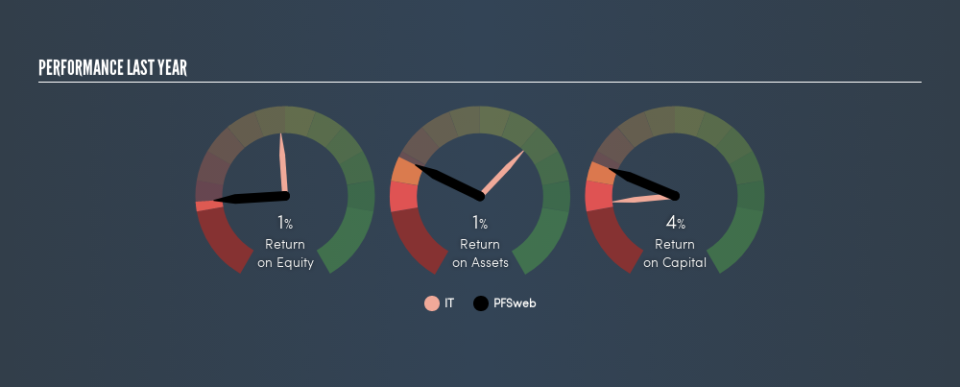Why We’re Not Impressed By PFSweb, Inc.’s (NASDAQ:PFSW) 3.9% ROCE

Today we'll look at PFSweb, Inc. (NASDAQ:PFSW) and reflect on its potential as an investment. Specifically, we're going to calculate its Return On Capital Employed (ROCE), in the hopes of getting some insight into the business.
First of all, we'll work out how to calculate ROCE. Next, we'll compare it to others in its industry. Last but not least, we'll look at what impact its current liabilities have on its ROCE.
Return On Capital Employed (ROCE): What is it?
ROCE measures the 'return' (pre-tax profit) a company generates from capital employed in its business. All else being equal, a better business will have a higher ROCE. Ultimately, it is a useful but imperfect metric. Renowned investment researcher Michael Mauboussin has suggested that a high ROCE can indicate that 'one dollar invested in the company generates value of more than one dollar'.
How Do You Calculate Return On Capital Employed?
The formula for calculating the return on capital employed is:
Return on Capital Employed = Earnings Before Interest and Tax (EBIT) ÷ (Total Assets - Current Liabilities)
Or for PFSweb:
0.039 = US$4.6m ÷ (US$190m - US$72m) (Based on the trailing twelve months to June 2019.)
Therefore, PFSweb has an ROCE of 3.9%.
See our latest analysis for PFSweb
Is PFSweb's ROCE Good?
One way to assess ROCE is to compare similar companies. In this analysis, PFSweb's ROCE appears meaningfully below the 9.5% average reported by the IT industry. This could be seen as a negative, as it suggests some competitors may be employing their capital more efficiently. Regardless of how PFSweb stacks up against its industry, its ROCE in absolute terms is quite low (especially compared to a bank account). It is likely that there are more attractive prospects out there.
In our analysis, PFSweb's ROCE appears to be 3.9%, compared to 3 years ago, when its ROCE was 0.5%. This makes us think the business might be improving. You can click on the image below to see (in greater detail) how PFSweb's past growth compares to other companies.
Remember that this metric is backwards looking - it shows what has happened in the past, and does not accurately predict the future. Companies in cyclical industries can be difficult to understand using ROCE, as returns typically look high during boom times, and low during busts. ROCE is, after all, simply a snap shot of a single year. Future performance is what matters, and you can see analyst predictions in our free report on analyst forecasts for the company.
How PFSweb's Current Liabilities Impact Its ROCE
Short term (or current) liabilities, are things like supplier invoices, overdrafts, or tax bills that need to be paid within 12 months. The ROCE equation subtracts current liabilities from capital employed, so a company with a lot of current liabilities appears to have less capital employed, and a higher ROCE than otherwise. To counter this, investors can check if a company has high current liabilities relative to total assets.
PFSweb has total assets of US$190m and current liabilities of US$72m. Therefore its current liabilities are equivalent to approximately 38% of its total assets. With a medium level of current liabilities boosting the ROCE a little, PFSweb's low ROCE is unappealing.
The Bottom Line On PFSweb's ROCE
There are likely better investments out there. Of course, you might find a fantastic investment by looking at a few good candidates. So take a peek at this free list of companies with modest (or no) debt, trading on a P/E below 20.
If you like to buy stocks alongside management, then you might just love this free list of companies. (Hint: insiders have been buying them).
We aim to bring you long-term focused research analysis driven by fundamental data. Note that our analysis may not factor in the latest price-sensitive company announcements or qualitative material.
If you spot an error that warrants correction, please contact the editor at editorial-team@simplywallst.com. This article by Simply Wall St is general in nature. It does not constitute a recommendation to buy or sell any stock, and does not take account of your objectives, or your financial situation. Simply Wall St has no position in the stocks mentioned. Thank you for reading.

